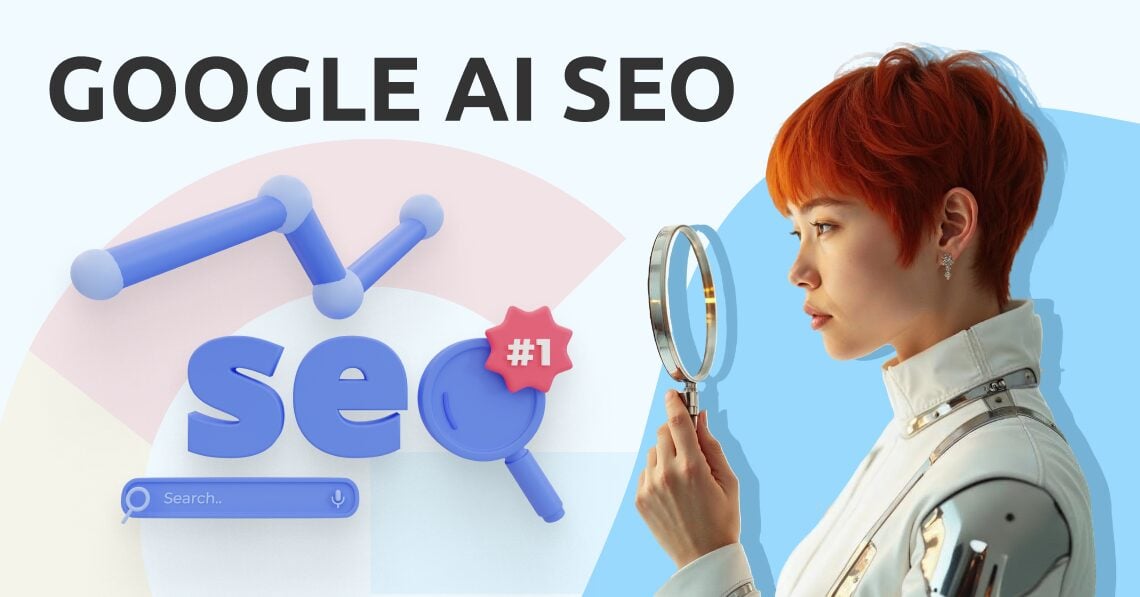The rapid growth of the internet, technological advancements, changing consumer habits, and evolving market trends have brought significant improvements in digital marketing. It has also emerged as a powerful tool for enhancing how businesses interact with customers.
As the digital age grows even more advanced, the value of digital marketing will only become more pronounced and will continue to be adopted by organizations. Learn about the best digital marketing campaigns and how you can use them to boost your business.
Innovative Use of Platforms and Technologies
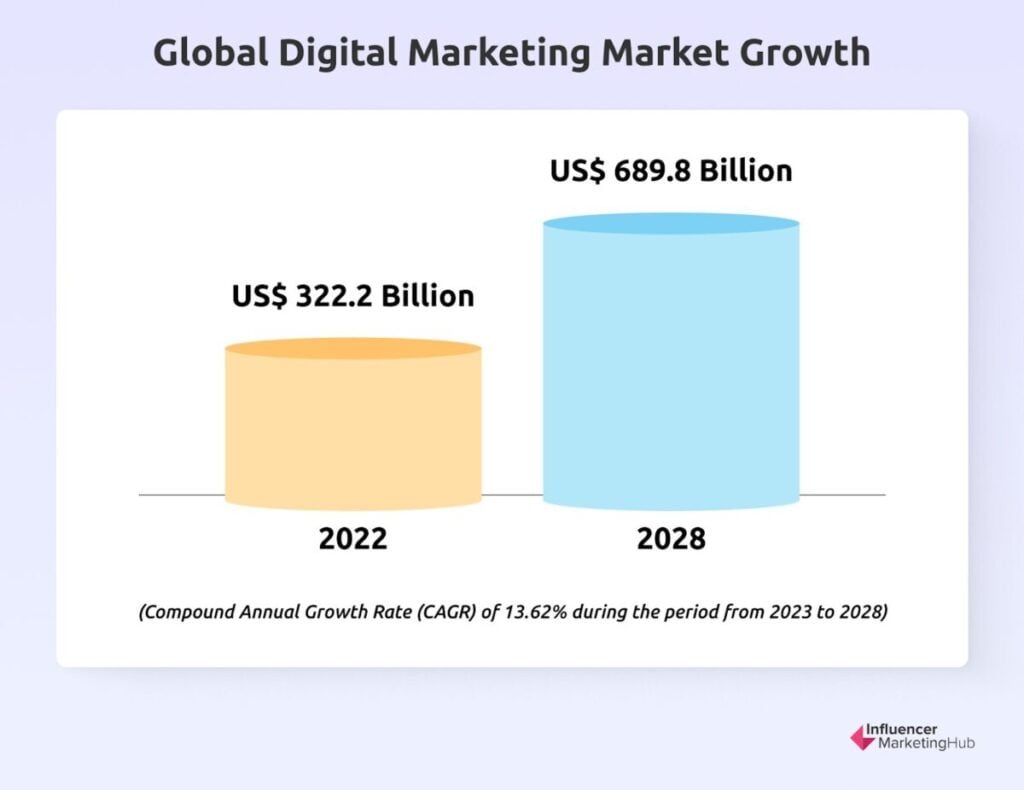
Digital Marketing Market
The "Digital Marketing Market by Digital Channel, End Use Industry, and Region 2023-2028" report reveals that the market for global digital marketing grew by US$322 billion in 2022. Industry experts predict the size to soar to $690 billion by 2028.
This is why businesses are eager to make the most of digital marketing, which has been proven to be capable of generating major increases in brand awareness. The case studies below showcase campaigns that highlight the adept use of various digital marketing platforms to do just that.
Coca-Cola’s Generative AI “Christmas Card” Campaign
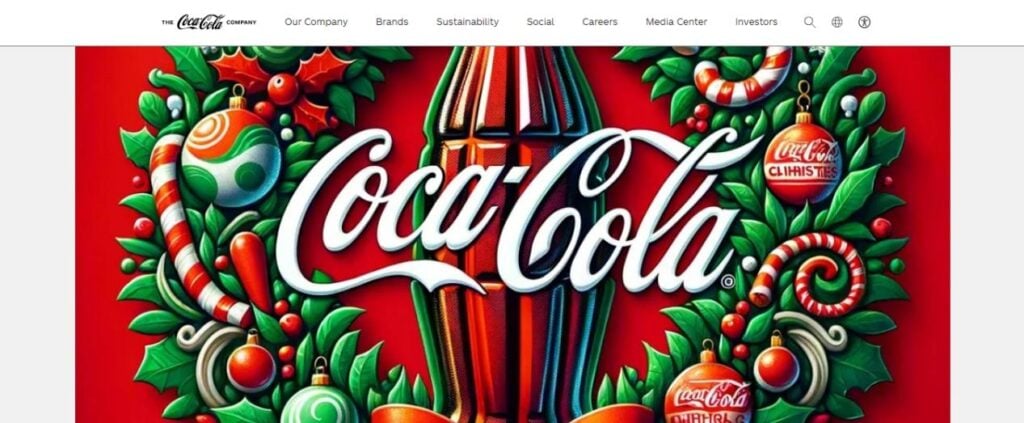
Coca-Cola’s Generative AI “Christmas Card” Campaign
In December, soda giant Coca-Cola launched its first generative AI campaign to engage consumers through its festive Christmas Card initiative. The campaign highlighted Create Real Magic, the first AI platform that combined the functionalities of two of the most popular AI programs, ChatGPT-4 and DALL-E. Site visitors used the Christmas card-generator tool to create their own Coke-themed holiday cards, which they could then send to anyone they wanted.
The latest AI initiative from Coca-Cola showcases festive and optimistic customer engagement, allowing consumers to creatively express themselves by letting them play with the brand. According to a company official, compared with their typical content, their AI initiatives generate twice the engagement of any other content type they make.
With this initiative, the company intended to connect people “in a uniquely real and magical way.” They capitalized on their diverse creative assets and took advantage of the latest AI tools to capture and engage their audience. The strategy of allowing their audience to use their archived iconic images—such as Sundblom’s 1931 Santa Claus, Coke caravan trucks, and Coke polar bears—was an effective way to gain visual ground and make their presence felt outside of the usual advertising and marketing platforms.
Through this campaign, the brand connects not only with the ones creating the cards but with every person who received the holiday cards as well. As they served as ‘carriers’ of holiday messages, the cards were also able to communicate the company’s intangible values and connect with both the sender and the receiver on a more personal level.
The company reported that users engaged on the AI platform for more than seven minutes and shared more than 120,000 pieces of content. Through this platform, Coca-Cola was able to interact with consumers from different parts of the globe.
Coca-Cola is an extensive user of digital marketing, having a formidable presence on popular social media platforms like Facebook, Instagram, YouTube, and X (formerly Twitter). The company’s understanding of the impact of advertising is reflected in its being a big ad spender. In the first quarter of 2023 alone, it spent approximately $128 million.
Key Takeaway:
Harnessing the power of user-generated content is a cost-effective way of promoting brands and reaching out to consumers by way of emotional marketing.
JetBlue Airways
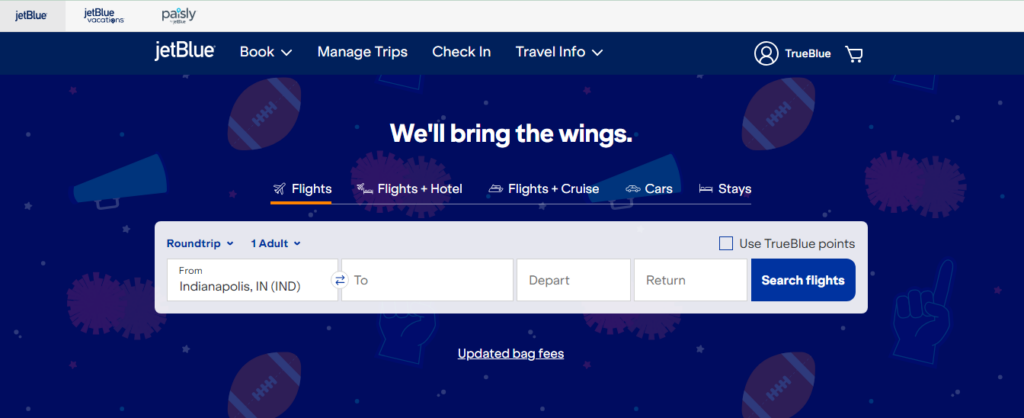
JetBlue Airways
JetBlue Airways, commonly known as jetBlue, is a New York-based low-cost airline that successfully leverages social media marketing to set itself apart from other budget airlines notorious for delivering subpar customer service. Its adept use of Twitter has helped cement its reputation for quickly resolving customer issues. This approach creates a brand image that speaks of accessibility, accountability, integrity, and transparency. It presents the company as one that is safe and caring—one that customers can truly trust to provide the kind of travel experience that they’re looking for.
The company fully utilizes Twitter by monitoring mentions, quickly replying to tweets, and responding to inquiries or concerns in a timely manner—with an average response time of ten minutes. It also encourages customers to share their stories, participate in travel-related polls, and encourage engagement through puns, wordplay, memes, and other forms of lighthearted tweets.
This kind of engagement creates constant online conversations that keeps the buzz about the company going. The consistency and frequency of their responses on X are critical factors to ensure that customers have something to look forward to. Closely monitoring the feed and punctually responding to concerns ensure that customers feel that they’re seen and heard.
JetBlue’s customer-centric approach significantly improves the customer experience, makes clients feel valued, enhances credibility, and fosters trust, allowing jetBlue to cultivate deeper relationships with its clients. It also signifies a serious commitment to innovation and the complete integration of technology in its digital marketing efforts.
Key Takeaway:
High-tech is not always ‘high-touch.’ Consistent connection with your customers through engagement in digital marketing campaigns is still worth the time and effort.
Creative Influencer Marketing Campaigns
Influencer marketing campaigns refer to collaborations, often on social media platforms, with individuals having significant influence over a specific target audience. These influencers are popular in their niche, are often experts in their fields, or have similar authority on certain subjects. Because they have a significant following, they can more effectively promote a brand or service that they support to their followers.
Influencer marketing is set to grow to around $24 billion by the end of 2024. These are some case studies on how certain companies used influencer marketing campaigns to enhance their credibility and brand reach, resulting in significant financial gains.
McDonald’s #RaiseYourArches
In January 2023, fast food company McDonald’s launched a campaign where it transformed its famous Golden Arches into raised eyebrows. The #RaiseYourArches campaign was a collaborative effort composed of a diverse group of creators featuring TV personalities, dancers, food enthusiasts, makeup artists, musicians, and fashion micro-influencers.
What’s unique about this campaign is that it did not include its restaurants or its food in its imagery and messaging. It was the universality of the McDonald’s arches that took centerstage as various influencers were given free rein to put their own creative take on how to ‘dress up’ the arches. The build-up of the campaign was planned and timed in three stages from “Seed the Brows,” to “Scale the Brows,” and to “Spread the Brows.” The response snowballed and resulted in immense virality all around the globe.
The campaign was expanded to over 30 markets around the world and was also accompanied by a digital sales promotion initiative. It was likewise widely shared on social media, with Instagram Lenses and Snapchat supporting it by raising the user’s arches.
The impact of #RaiseYourArches was undeniable. It generated 10 million views, 4.4 million impressions, and 317,000 engagements across various platforms, achieving a remarkable 98% brand recognition for McDonald’s.
Key Takeaway:
An integrated digital marketing campaign across linked platforms and channels can yield exponential results in terms of reach and resonance. Make sure that you have a relevant message and solid communication strategy to pack power into your campaign.
Blue’s Clues Actor and Flock Freight’s “Define Your Load” Campaign
Trucking and logistics company Flock Freight uses puns and infuses humor in its “Define Your Load” campaign featuring Blue’s Clues' former host, Steve Burns. Recognized by multiple generations, Burns plays as an “investigative journalist” and provides a unique breakdown of how Flock Freight works.
This is a unique angle from which to approach marketing a logistics company. Flock Freight veers away from the usual imagery with this young-ish campaign. The marketing brains behind this campaign sat on the “Thinking Chair” and devised a plan from an engineer’s standpoint: he defined scenarios, identified risks, tested his hypothesis, and set up metrics. The result was a campaign that is fresh, colorful, and fun—definitely attention-grabbing.
At the same time, the campaign was also data-driven. Every variable in the campaign was tested, analyzed, and measured. This allowed them to formulate marketing messages that are understandable to their target market and that would most likely prompt them to respond to their call to action. More importantly, consistently monitoring these metrics and analyzing them would allow the company to consequently make the necessary iterations in their current and future campaigns.
This unconventional campaign left an impactful mark on the target audience. It earned the company a 181% increase in brand recognition and thousands of new social media followers. The initiative also increased the average time on the company’s social media profiles. It even won an award in June 2023 for the B2B Creative in the Challenger Brand category.
Key Takeaway:
Thinking out of the box is a great way to approach your marketing campaigns. Come up with more exciting ways to communicate the same marketing messages from a new perspective.
Choosing Influencers to Work With
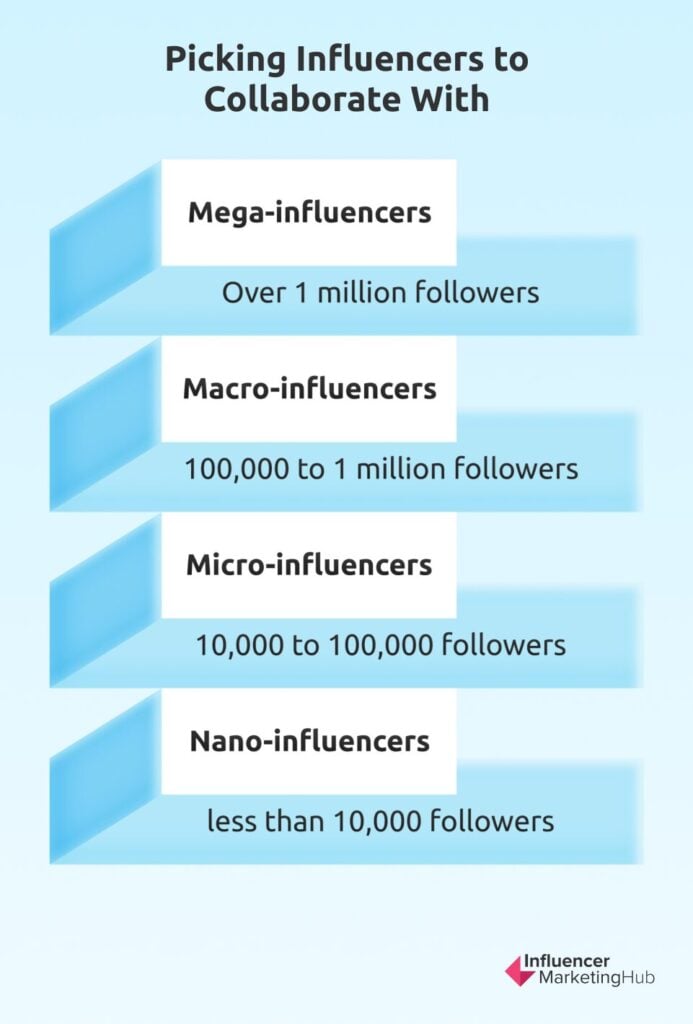
Picking influencers to collaborate with
Influencer marketing works when an audience trusts and believes in the influencer. This is why when an influencer talks about a product or service, their followers are inclined to trust the influencer’s recommendation. This is why it’s crucial that you choose the right influencer, of which there are four types.
Mega influencers
The first group is referred to as the mega influencers or individuals with over 1 million followers. They are typically famous actors, athletes, and other public figures with celebrity status that can provide massive brand exposure. However, they can command extremely expensive rates.
Macro-influencers
These individuals have 100,000 to 1 million followers. They’ve created a name in their respective fields for consistent content creation and engagement with their audience, though they haven’t quite reached the level of the mega influencer.
Micro-influencers
These influencers have 10,000 to 100,000 followers. Also called “rising stars,” they have a recognizable presence on particular digital platforms. Despite their smaller follower count, they are known to have a 60% higher engagement rate than macro-influencers.
Nano-influencers
These individuals have less than 10,000 followers. They are your everyday social media users and content creators with a much smaller audience. Despite that, they usually have more niche communities and a dedicated following around a specific interest.
Execution Strategies for Impactful Influencer Collaborations
Influencer marketing stands out as one of the marketing channels with the highest return on investment (ROI). Apply these strategies to maximize the effectiveness of your partnership with an influencer.
1. Collaborate with your influencer on content creation.
During the content creation process for your brand, involve your influencer. Ask for their input on the different aspects involved in creating content. Work together to ensure the collaboration is aligned with your goals.
The Hyundai Santa Fe launch is a great example of how effective this approach is. To raise awareness for its latest SUV model, Hyundai collaborated with select influencers curated by the Influencer Marketing Factory. The influencers were invited to the launch event and given personalized creative briefs so they could showcase the features of Hyundai Santa Fe while having the freedom to display their distinct creative styles. This made sure that each influencer can engage their respective audiences and effectively promote the campaign’s objectives.
2. Incorporate storytelling into your collaboration.
Share stories that your audience can relate to and encourage them to share the content with others. Consider adding personal experiences into the content to create a deeper emotional connection with both your and your influencer’s followers.
Luxury lingerie brand Natori, with the help of The Shelf, achieved a 4.42% engagement rate on Instagram alone by implementing this strategy. They ran a spring campaign that involved women influencers sharing their personal stories and sparking genuine conversations on social media channels. With emotive storytellers like Toshiko Shek, Ashley Dorough, and Nkenge Brown on board, the campaign reached 8,000,000 people and generated over 200,000 engagements.
3. Boost content produced by your influencer.
Use your own channels and platforms, such as your website, social media, and newsletters, to advertise your collaboration and share campaign content.
Filip Tysander propelled his watch brand Daniel Wellington to success using this strategy. When he first launched the brand, he reached out to influencers from different niches, offered them free products and actively engaged with their user-generated content. Not only did he comment on the influencers’ posts but also got their permission to use their user-generated content (UGC) on Daniel Wellington social media pages and marketing materials. By leveraging influencers and their UGC, a million Daniel Wellington watches were sold in just 3 years, earning them a total of $228 million–an amazing feat for a new brand.
4. Consider paid media campaigns to amplify your influencer-produced content.
Repurposing content using paid channels can help you get added value for content that you’ve already made. Just make sure to discuss this option before getting into any contracts with a potential influencer.
Grin used this approach to help Branch Basics, a direct-to-consumer (DTC) brand for non-toxic cleaning products, get the most out of its influencer partnerships. Branch Basics reaches out to 300 new creators monthly and manages around 100 to 150 affiliates per month. It sends out free products to select creators and encourages them to create authentic content that captures their target audience. Creators that perform well are then offered a paid partnership and the highest-performing content repurposed across its marketing mix.
Measuring the Success of Your Digital Marketing Campaign
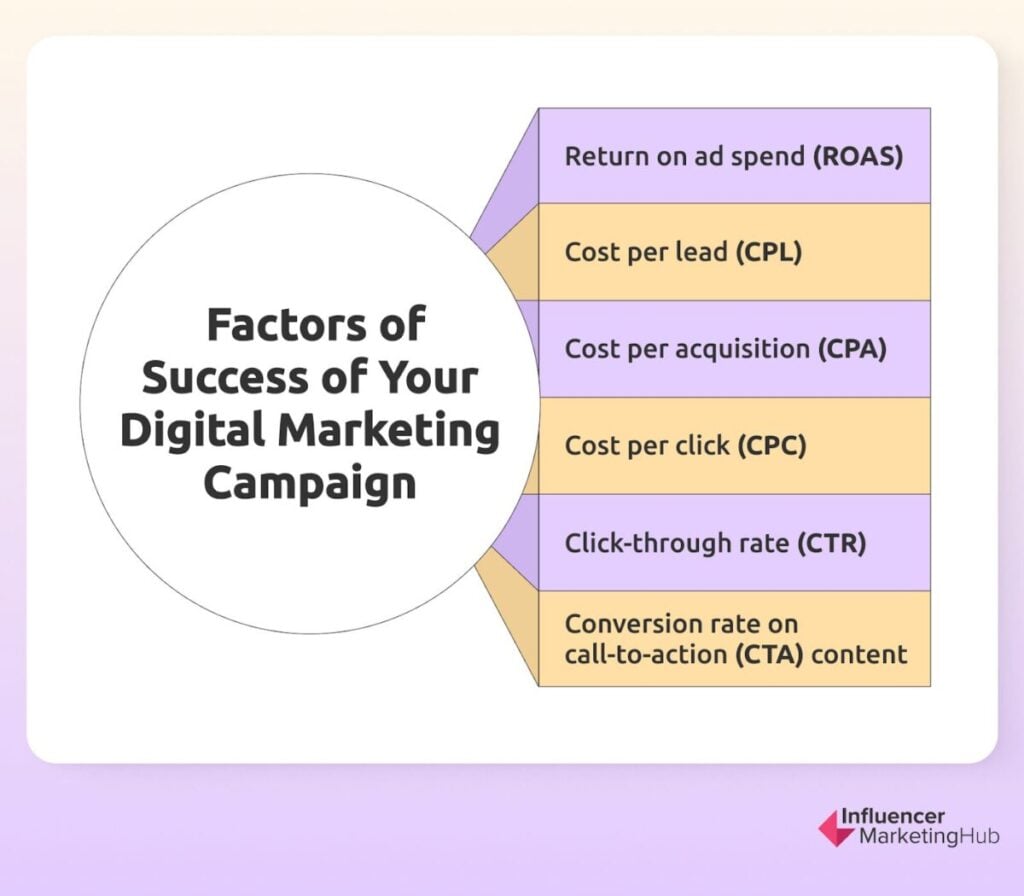
Digital Marketing Campaign
When measuring the success of your campaign, it’s important to have a measurement framework. Campaign measurement refers to evaluating the impact of your marketing initiative against your campaign goals.
Before creating a campaign, define the core metrics and marketing goals you want to achieve. The most common are conversions, cost per conversion, and total sales. Being clear with your metrics from the start can help you adhere to the relevant key performance indicators (KPIs).
KPIs are metrics essential in helping you get a quantitative understanding of the impact of your marketing campaign. These include the following:
- Return on ad spend (ROAS). This refers to the revenue you earn for every dollar spent on an advertising campaign.
- Cost per lead (CPL). This shows the amount you spent on each lead you acquired.
- Cost per acquisition (CPA). This refers to the cost incurred for every customer you gain.
- Cost per click (CPC). This is the cost you incur every time a customer clicks on your ad.
- Click-through rate (CTR). This is the number of users who clicked the content in your campaign or marketing email.
- Conversion rate on call-to-action (CTA) content. This measures how effectively a CTA prompt was able to convert a customer. This can mean having them sign up for an e-book or checking out their carts before a sale date ends.
Your campaign should have a clearly defined goal and a specific purpose that will help provide direction and focus. It can be to increase revenue, attract more leads, or improve brand recognition. Establishing a goal will also help you have a clear understanding of the factors you need to measure.
In preparing your campaign, make sure to also set a specific time frame to ensure focus, accountability, and efficient allocation of resources. This helps facilitate strategic planning for your brand’s direction based on the performance of the campaign.
Wrapping Up
Making full use of digital marketing in creating and implementing your online campaigns is crucial. In today’s rapidly evolving digital landscape, fully adopting digital marketing in your online campaigns gives you a major advantage in letting your brand thrive in this fast-paced era.
Since online channels are already such an integral part of the major population’s daily routines, digital marketing provides your business with countless opportunities to connect and engage with customers. With digital marketing, your brand benefits from precise targeting and constant optimization, allowing you to maximize your marketing ROI, stay competitive in your field, and flourish in the digital age.
